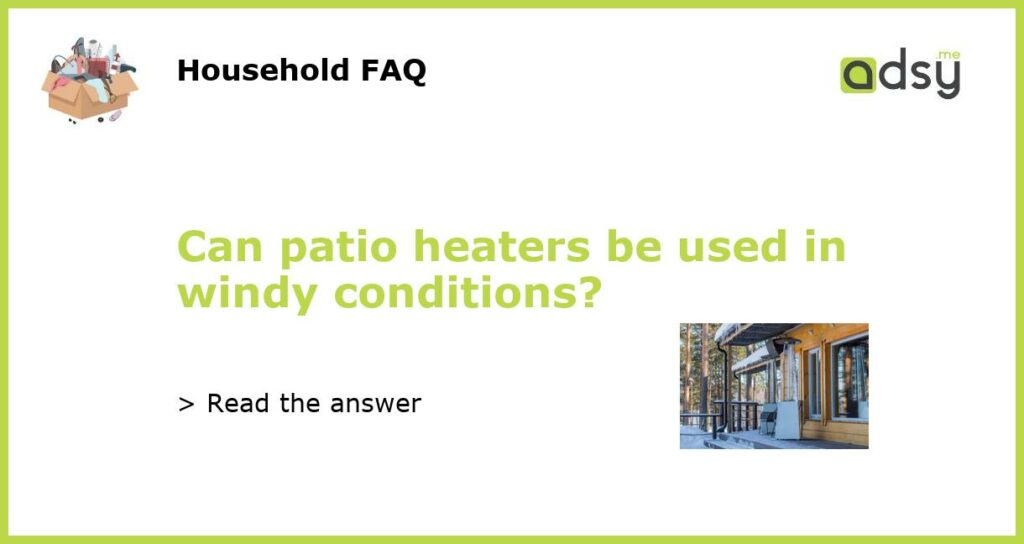Yes, patio heaters can be used in windy conditions
Patio heaters are a popular choice for outdoor heating, providing warmth and comfort during colder months. However, one common concern about using patio heaters is their effectiveness in windy conditions. While it is true that wind can affect the performance and efficiency of patio heaters, there are ways to mitigate these challenges and still enjoy the benefits of outdoor heating. In this article, we will explore the impact of wind on patio heaters and provide tips for using them in windy conditions.
The impact of wind on patio heaters
When it comes to using patio heaters in windy conditions, it is important to understand the impact of wind on their performance. Wind can affect the efficiency of patio heaters in several ways:
Heat dispersion
Strong winds can cause heat to dissipate more quickly, making it difficult for patio heaters to warm a specific area effectively. The warm air produced by the heater can be blown away, resulting in less warmth reaching the desired area. This is especially true for open-air or tabletop patio heaters that are more susceptible to wind interference.
Fuel consumption
In windy conditions, patio heaters may consume more fuel to produce sufficient heat. The constant exposure to wind can cause the heater to work harder and burn fuel at a faster rate. This can lead to increased gas or electricity consumption, reducing the cost-effectiveness of using patio heaters in windy conditions.
Flame extinguishment
Strong winds can potentially blow out the flame in patio heaters, rendering them ineffective. This can be a safety concern, as the unburned gas may accumulate and pose a fire hazard. Patio heaters with built-in safety features, such as a flame failure device (FFD), can help prevent accidents by automatically shutting off the gas supply if the flame goes out.
Using patio heaters in windy conditions: Tips and considerations
Although wind can pose challenges for using patio heaters, there are several tips and considerations that can help optimize their performance in such conditions:
Positioning
Positioning the patio heater strategically can minimize the impact of wind. Placing the heater in a sheltered area, such as against a wall or under a pergola, can provide a barrier against strong winds. Additionally, consider adjusting the angle or direction of the heater to maximize heat distribution and minimize heat dispersion caused by wind.
Windbreaks
Creating a windbreak around the patio heater can help shield it from strong winds. This can be achieved by using physical barriers, such as screens or fences, or natural elements like tall plants or hedges. The windbreak should be positioned in a way that redirects the wind away from the heater, allowing it to operate more effectively.
Choose the right type of patio heater
Not all patio heaters are created equal when it comes to wind resistance. Some models are designed to be more wind-resistant than others. Look for patio heaters that have features like a weighted base, stable construction, and a strong heat output to withstand windy conditions. Electric patio heaters, such as infrared or halogen heaters, may be more suitable for windy areas as they are less affected by wind.
Use wind-resistant accessories
Using wind-resistant accessories can further enhance the performance of patio heaters in windy conditions. Items like patio umbrella covers, wind guards, or dome-shaped screens can help protect the flame and prevent heat dispersion caused by wind. These accessories are often designed specifically for patio heaters and can be easily attached or removed as needed.
Regular maintenance
Regular maintenance of patio heaters is essential for optimal performance, especially in windy conditions. Keep the heater clean and free from debris that could potentially interfere with its operation. Check for any loose or damaged components and repair or replace them as necessary. Following the manufacturer’s instructions for maintenance and operation can help ensure the longevity and effectiveness of your patio heater.
In conclusion, patio heaters can be used in windy conditions with proper precautions and considerations. Understanding the impact of wind on their performance and implementing strategies to mitigate these challenges can help maximize the effectiveness of patio heaters and provide warmth and comfort in outdoor spaces. Whether you are enjoying a meal on your patio or hosting a gathering in a backyard, patio heaters can still be an excellent choice for outdoor heating, even in less than ideal weather conditions.






